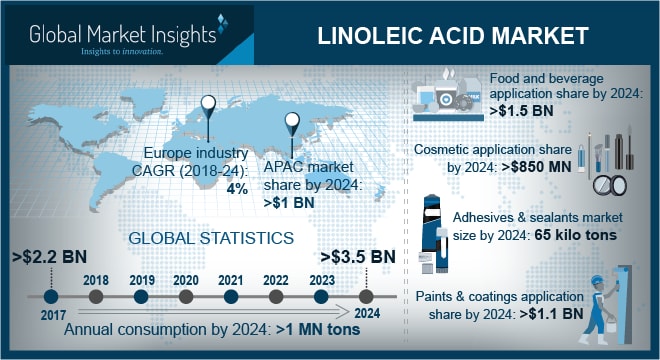Linoleic Acid Market Current Trends, Industry Analysis & Future Opportunities by 2024
Linoleic acid market has, in the last couple of decades, gained
considerable significance on account of the surging importance of omega 6
fatty acids that contribute toward increased nutritional value. Of
late, the masses have undergone a tremendous change in their food
consumption habits, having considered the benefits of eating healthy.
Given that linoleic acid provides substantial benefits for numerous
problems – right from skin care to hair loss, many of the giants in linoleic acid industry
have been continuously involved in R&D activities to develop
various medicinal formulations. The vast expanse of linoleic acid market
is evident from the fact that even cosmetic manufacturers have included
the product as the main ingredient in numerous skin care creams.
In the last few years, players in
linoleic acid market have been experiencing a supportive scenario for
their business across several geographies. The commercialization of raw
material production required for developing linoleic acid has been one
the major reasons behind the increasing number of strategic
opportunities for these companies. Validating the aforementioned fact,
recently, Australian regulators gave the nod of approval to GO Resources
Pty Ltd to cultivate genetically modified safflower commercially across
Australia. As of now, they intended to use the oil extracted from
safflower for industrial applications. The growing cultivation of
primary raw material aided by a supportive regulatory frame of reference
is poised to boost linoleic acid industry trends over the years ahead.
In Australia alone, many pharma and cosmetic companies have expanded
their product development facilities in last few years, solely due to
the favorable regulatory support.
Recently, the cosmetic industry has been
experiencing a massive shift of sorts, driven by a slew of new product
developments and technology interventions, which ironically, are proving
to be rather opportunistic for the giants in linoleic acid market.
Merely a few months ago, a renowned manufacturer of skin care products,
Cosmetic Solutions launched a unique skin-brightening and
super-hydrating serum, specially formulated to lighten the skin tone. In
yet another instance, an AI company, Insilico developed
high-performance computer simulations with the help of which
pharmaceutical companies can develop a precise formula for anti-aging
pathways. The innovative combination of deep learning technology and
pioneering anti-aging research is thus slated to fuel linoleic acid
industry outlook over the years ahead.
In the last few decades, the
commercialization of linoleic acid has been increasing mainly across
U.S. The surging use of linoleic acid in dietary supplements and
cosmetic formulations have been instrumental in impelling the expansion
of the regional linoleic acid industry. Indeed, the product has found
its place in dietary supplements, now consumed by patients suffering
from chronic disorders and several other vitamin deficiencies. For the
record, as per a survey carried out in U.S. in 2017, 76% adults use
dietary supplements. Meanwhile, the FDA has also granted approval for
the use of several dietary supplements as a disease-modifying treatment
for various chronic diseases. It has been observed that even clinicians
are educating patients about the benefits of using supplements, which is
turning out to be opportunistic for the players in linoleic acid
market.
Considering the anti-diabetic and
anticancer properties of a combination of geometric and positional
isomers of linoleic acid, the scientific community has suggested using
them as poultry nutrients. The dietary inclusion of linoleic acid in
poultry diet would provide numerous health benefits to the consumers
since it contains low fat and cholesterol. The growing consumption of
poultry meat and other meat products across the globe will thus
eventually have a significant influence on linoleic acid industry share
over the coming years.
It would be rather imperative to mention
that the ongoing technological innovations in the healthcare and
pharmaceutical sectors to provide nutritious products to consumers are
poised to expedite linoleic acid market size. The shifting focus toward
the consumption of multifunctional and nutrient rich products will thus
have a positive impact on the product demand. The highly ambitious and
strategic research approach adopted by bio-pharma and biotechnology
companies toward the modification of raw material required for linoleic
acid will also have a remarkable influence on product consumption trends
across the globe. For the record, by the end of 2024, linoleic acid
market will surpass a revenue collection of USD 3.5 billion.




